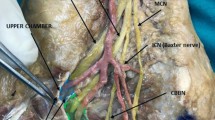Abstract
Posteromedial tarsal tunnel syndrome is a disorder affecting the tibial nerve or its branches. Diagnosis is established on the basis of physical examination and can be confirmed by electrophysiological evidence. However, diagnostic imaging is always required to identify the possible site of compression. High-resolution ultrasound (US) is playing an increasingly important role in the study of the nerves thanks to a series of advantages over magnetic resonance imaging, such as lower costs and widespread availability, high spatial resolution, fast examination using axial scans, dynamic and comparative studies, possibility of carrying out a study with the patient in the standing position, US Tinel sign finding, and the contribution of color/power Doppler US. We present the results obtained in a series of 81 patients who underwent US imaging between 2008 and 2013 due to posteromedial tarsal tunnel syndrome.
Riassunto
La sindrome del tunnel tarsale posteriore-mediale è una sofferenza del nervo tibiale o di un suo ramo. La diagnosi è clinica e può essere confermata dall’elettrofisiologia, ma un’indagine con imaging è sempre necessaria per trovare l’elemento di compressione. L’ecografia ad alta risoluzione sta giocando un ruolo sempre più importante per lo studio dei nervi, per i diversi vantaggi rispetto alla risonanza magnetica: costo e disponibilità, risoluzione spaziale, esplorazione rapida mediante tecnica di scansione assiale, dinamica e comparativa, possibilità di uno studio con paziente in piedi, segno di Tinel ecografico, contributo del Doppler.



















Similar content being viewed by others
References
Erickson SJ, Quinn SF, Kneeland JB, Smith JW, Johnson JE, Carrera GF et al (1990) MR imaging of the tarsal tunnel and related spaces: normal and abnormal findings with anatomic correlation. AJR Am J Roentgenol 155:323–328
Kerr R, Frey C (1991) MR imaging in tarsal tunnel syndrome. J Comput Assist Tomogr 15(2):280–286
Martinoli C, Bianchi S, Gandolfo N, Valle M, Simonetti S, Derchi LE (2000) US of nerve entrapments in osteofibrous tunnel of the upper and lower limbs. Radiographics 20(6):1818 Spec No: S199–213; discussion S213–7. Erratum in: Radiographics 2000 Nov–Dec
Fantino O, Coillard JY, Borne J, Bordet B (2011) Ultrasound of the tarsal tunnel: normal and pathological imaging features. J Radiol 92(12):1072–1080
Demondion X, Boutry N, Bry R, Khalil C, Jaspart M, Cotten A (2007) Tibial nerve entrapment syndromes at the ankle and foot level: imaging assessment. Rev Rhum 74:409–414
Nagaoka M, Matsuzaki H (2005) Ultrasonography in tarsal tunnel syndrome. J Ultrasound Med 24(8):1035–1040
Bouysset M, Coury F, Labarre-Vila A, Damiano J, Gerbay B, Tebib J (2012) Considérations sur le syndrome du canal tarsien postéromédial et les formes apparentées (lésions du nerf tibial et de ses branches). Méd Chir Pied 28:69–72
Lau JT, Daniels TR (1999) Tarsal tunnel syndrome: a review of the literature. Foot Ankle Int 20:201–209
Demondion X (2011) Anatomie normale des nerfs du pied, les sièges du conflit. In: Le pied, GETROA-GEL OPUS XXXVIII. Sauramps Médical, Montpellier p 243–52
Lee MF, Chan PT, Chau LF, Yu KS (2002) Tarsal tunnel syndrome caused by talocalcaneal coalition. Clin Imaging 26:140–143
Garchar DJ, Lewis JE, DiDomenico LA (2001) Hypertrophic sustentaculum tali causing a tarsal tunnel syndrome: a case report. J Foot Ankle Surg 40:110–112
Fujita I, Matsumoto K, Minami T, Kizaki T, Akisue T, Yamamoto T (2004) Tarsal tunnel syndrome caused by epineural ganglion of the posterior tibial nerve: report of 2 cases and review of the literature. J Foot Ankle Surg 43(3):185–190
Pasku DS, Karampekios SK, Kontakis GM, Katonis PG (2009) Varicosities as an etiology of tarsal tunnel syndrome and the significance of tinel’s sign: report of two cases in young men and a review of the literature. J Am Podiatr Med Assoc 99(2):144–147
Gould N, Alvarez R (1983) Bilateral tarsal tunnel syndrome caused by varicosities. Foot Ankle 3:290–292
Kim E, Childers MK (2010) Tarsal tunnel syndrome associated with a pulsating artery: effectiveness of high-resolution ultrasound in diagnosing tarsal tunnel syndrome. J Am Podiatr Med Assoc 100(3):209–212
Wittmayer BC, Freed L (2007) Diagnosis and surgical management of flexor digitorum accessorius longus-induced tarsal tunnel syndrome. J Foot Ankle Surg 46:484–487
Ghosh SK, Raheja S, Tuli A (2013) Potential sites of compression of tibial nerve branches in foot: a cadaveric and imaging study. Clin Anat 26(6):768–779
Chen WS (1992) Lipoma responsible for tarsal tunnel syndrome. Apropos of 2 cases. Rev Chir Orthop Reparatrice Appar Mot 78(4):251–254
Conflict of interest
Olivier Fantino declares that he has no conflict of interest related to this study.
Informed consent
All procedures followed were in accordance with the ethical standards of the responsible committee on human experimentation (institutional and national) and with the Helsinki Declaration of 1975, as revised in 2000. Informed consent was obtained from all patients.
Animal studies
The study described in this article did not include any procedures involving animals.
Author information
Authors and Affiliations
Corresponding author
Rights and permissions
About this article
Cite this article
Fantino, O. Role of ultrasound in posteromedial tarsal tunnel syndrome: 81 cases. J Ultrasound 17, 99–112 (2014). https://doi.org/10.1007/s40477-014-0082-9
Received:
Accepted:
Published:
Issue Date:
DOI: https://doi.org/10.1007/s40477-014-0082-9




